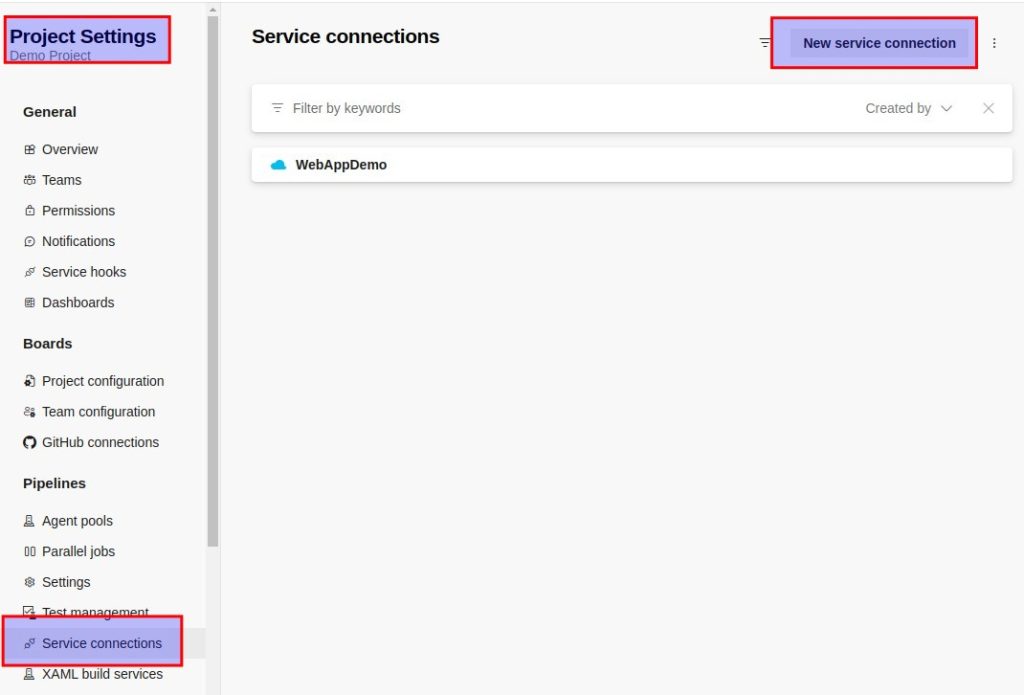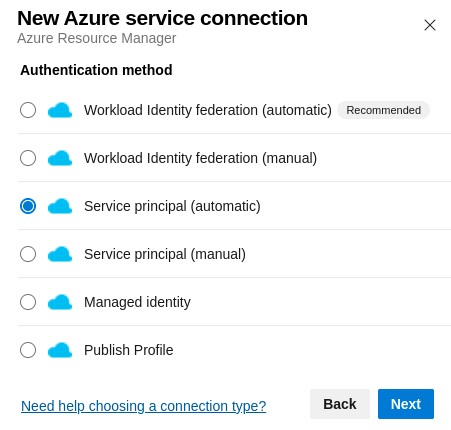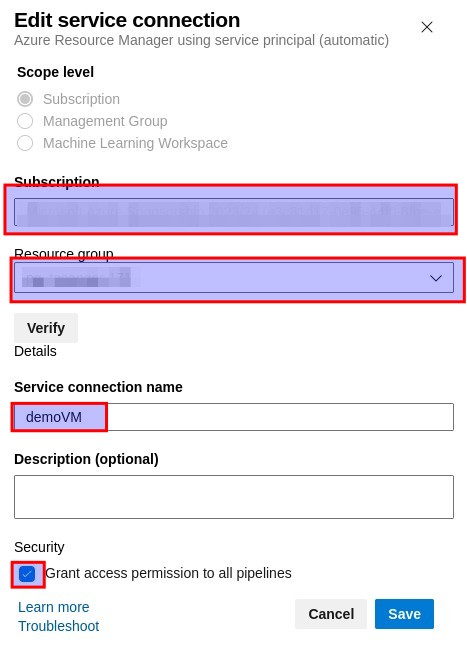Azure
Zuerst muss ein Service Principal erstellt werden damit in einer Ci/CD Pipeline automatisch eingeloggt werden kann
az login
az account set --subscription "your-subscription-id"
az ad sp create-for-rbac --name "<your-sp-name>" --role="Contributor" --scopes="/subscriptions/<your-subscription-id>"
Es kann auch ein Servie Principal für eine Resource Group erstellt werden:
az ad sp create-for-rbac --name "sp-pipeline" --role="Contributor" --scopes="/subscriptions/xxxx-xxxx-44f0-8fbe-xxxxx/resourceGroups/pg_xxxxx-171"Hier die Ausgaben
{
"appId": "xxxxxxxx-xxxx-xxxx-xxxx-xxxxxxxxxxxx",
"displayName": "<your-sp-name>",
"password": "xxxxxxxx-xxxx-xxxx-xxxx-xxxxxxxxxxxx",
"tenant": "xxxxxxxx-xxxx-xxxx-xxxx-xxxxxxxxxxxx"
}Diese Anmeldeinformationen können als Umgebaungsvariablen für Terraform gesetzt werden:
export ARM_CLIENT_ID="xxxxxxxx-xxxx-xxxx-xxxx-xxxxxxxxxxxx"
export ARM_CLIENT_SECRET="xxxxxxxx-xxxx-xxxx-xxxx-xxxxxxxxxxxx"
export ARM_SUBSCRIPTION_ID="xxxxxxxx-xxxx-xxxx-xxxx-xxxxxxxxxxxx"
export ARM_TENANT_ID="xxxxxxxx-xxxx-xxxx-xxxx-xxxxxxxxxxxx"In einer gitlab Pipeline könnte es so aussehen:
jobs:
deploy:
runs-on: ubuntu-latest
steps:
- name: Checkout code
uses: actions/checkout@v2
- name: Set up Terraform
uses: hashicorp/setup-terraform@v1
- name: Azure Login
env:
ARM_CLIENT_ID: ${{ secrets.ARM_CLIENT_ID }}
ARM_CLIENT_SECRET: ${{ secrets.ARM_CLIENT_SECRET }}
ARM_SUBSCRIPTION_ID: ${{ secrets.ARM_SUBSCRIPTION_ID }}
ARM_TENANT_ID: ${{ secrets.ARM_TENANT_ID }}
run: terraform initDie Terraform main.tf anlegen (Terrafom wird noch lokal ausgeführt)
Danach ein terraform apply um die VM zu deployen
# Anbieter-Konfiguration
provider "azurerm" {
features {}
}
# Verwende die bestehende Ressourcengruppe
data "azurerm_resource_group" "existing_rg" {
name = "rg_xxxxxxxx-171" # Deine bestehende Resource Group
}
# Virtuelles Netzwerk
resource "azurerm_virtual_network" "vnet" {
name = "myVnet"
address_space = ["10.0.0.0/16"]
location = data.azurerm_resource_group.existing_rg.location
resource_group_name = data.azurerm_resource_group.existing_rg.name
}
# Subnetz
resource "azurerm_subnet" "subnet" {
name = "mySubnet"
resource_group_name = data.azurerm_resource_group.existing_rg.name
virtual_network_name = azurerm_virtual_network.vnet.name
address_prefixes = ["10.0.1.0/24"]
}
# Netzwerkschnittstelle
resource "azurerm_network_interface" "nic" {
name = "myNic"
location = data.azurerm_resource_group.existing_rg.location
resource_group_name = data.azurerm_resource_group.existing_rg.name
ip_configuration {
name = "internal"
subnet_id = azurerm_subnet.subnet.id
private_ip_address_allocation = "Dynamic"
}
}
# Virtuelle Maschine
resource "azurerm_linux_virtual_machine" "vm" {
name = "myVM"
resource_group_name = data.azurerm_resource_group.existing_rg.name
location = data.azurerm_resource_group.existing_rg.location
size = "Standard_B1s"
admin_username = "azureuser"
admin_password = "Password4321"
network_interface_ids = [azurerm_network_interface.nic.id]
os_disk {
caching = "ReadWrite"
storage_account_type = "Standard_LRS"
}
source_image_reference {
publisher = "Canonical"
offer = "UbuntuServer"
sku = "18.04-LTS"
version = "latest"
}
}
# Öffentliche IP-Adresse
resource "azurerm_public_ip" "public_ip" {
name = "myPublicIP"
location = data.azurerm_resource_group.existing_rg.location
resource_group_name = data.azurerm_resource_group.existing_rg.name
allocation_method = "Dynamic"
}
# Sicherheitsgruppe für die VM
resource "azurerm_network_security_group" "nsg" {
name = "myNSG"
location = data.azurerm_resource_group.existing_rg.location
resource_group_name = data.azurerm_resource_group.existing_rg.name
security_rule {
name = "SSH"
priority = 1001
direction = "Inbound"
access = "Allow"
protocol = "Tcp"
source_port_range = "*"
destination_port_range = "22"
source_address_prefix = "*"
destination_address_prefix = "*"
}
}
# Netzwerkschnittstelle mit Sicherheitsgruppe verknüpfen
resource "azurerm_network_interface_security_group_association" "nic_nsg" {
network_interface_id = azurerm_network_interface.nic.id
network_security_group_id = azurerm_network_security_group.nsg.id
}Damit Terraform auch in der Pipeline deployed werden kann, muss der tfstate dort liegen, bzw. es muss auf ein gemeinsames Backend zugegriffen werden das den Terraform State enthält.
Dazu wird ein Storage in Azure erstellt indem das File gespeichert werden kann. Dies kann auch über terraform geschehen, dazu die main.tf mit der Storage Ressource erweitern und noch einmal neu mit terraform apply deployen:
# Storage Account erstellen
resource "azurerm_storage_account" "storage" {
name = "tfstatedemovm"
location = data.azurerm_resource_group.existing_rg.location
resource_group_name = data.azurerm_resource_group.existing_rg.name
account_tier = "Standard"
account_replication_type = "LRS"
}
# Storage Container erstellen
resource "azurerm_storage_container" "container" {
name = "tfstate"
storage_account_name = azurerm_storage_account.storage.name
container_access_type = "private"
}
output "storage_account_name" {
value = azurerm_storage_account.storage.name
}
output "container_name" {
value = azurerm_storage_container.container.name
}Jetzt kann auf das Azue Storage Backend umgestellt weden, dazu folgenden Block der main.tf hinzufügen:
terraform {
backend "azurerm" {
resource_group_name = "rg-xxxxxxx-171"
storage_account_name = "tfstatedemovm"
container_name = "tfstate"
key = "terraform.tfstate"
}
}Ein terraform init würde jetzt merken das die Backend Configuration geändert wurde und vorschlagen das mit terraform init -migrate-state das Terraform State in das Azure Backend migriert werden kann:
$ terraform init
Initializing the backend...
╷
│ Error: Backend configuration changed
│
│ A change in the backend configuration has been detected, which may require migrating existing state.
│
│ If you wish to attempt automatic migration of the state, use "terraform init -migrate-state".
│ If you wish to store the current configuration with no changes to the state, use "terraform init -reconfigure".
╵
$ terraform init -migrate-state
Initializing the backend...
Terraform detected that the backend type changed from "local" to "azurerm".
Do you want to copy existing state to the new backend?
Pre-existing state was found while migrating the previous "local" backend to the
newly configured "azurerm" backend. An existing non-empty state already exists in
the new backend. The two states have been saved to temporary files that will be
removed after responding to this query.
Previous (type "local"): /tmp/terraform3111667706/1-local.tfstate
New (type "azurerm"): /tmp/terraform3111667706/2-azurerm.tfstate
Do you want to overwrite the state in the new backend with the previous state?
Enter "yes" to copy and "no" to start with the existing state in the newly
configured "azurerm" backend.
Enter a value: yes
Successfully configured the backend "azurerm"! Terraform will automatically
use this backend unless the backend configuration changes.
Initializing provider plugins...
- Reusing previous version of hashicorp/azurerm from the dependency lock file
- Using previously-installed hashicorp/azurerm v4.1.0
Terraform has been successfully initialized!
You may now begin working with Terraform. Try running "terraform plan" to see
any changes that are required for your infrastructure. All Terraform commands
should now work.
If you ever set or change modules or backend configuration for Terraform,
rerun this command to reinitialize your working directory. If you forget, other
commands will detect it and remind you to do so if necessary.Jetzt muss noch eine Service Connection angelegt werden.
In den Project Settings auf Service Connection klicken
Auf „Azure Resource Manager“ klicken und dann auf „Service principal (automatic)“



Eine azure-pipelines.yml anlegen
Die azureSubscription ist der Name der soeben angelegten Service Connection (demoVM)
trigger:
- main # Oder dein Branch-Name
pool:
vmImage: 'ubuntu-latest'
variables:
ARM_CLIENT_ID: $(servicePrincipalId)
ARM_CLIENT_SECRET: $(servicePrincipalKey)
ARM_SUBSCRIPTION_ID: $(subscriptionId)
ARM_TENANT_ID: $(tenantId)
steps:
- checkout: self
- task: AzureCLI@2
inputs:
azureSubscription: 'demoVM' # Der Name der Azure Service Connection in Azure DevOps
scriptType: 'bash'
scriptLocation: 'inlineScript'
inlineScript: |
# Installiere Terraform
curl -o- https://raw.githubusercontent.com/tfutils/tfenv/master/install.sh | bash
export PATH="$HOME/.tfenv/bin:$PATH"
tfenv install latest
tfenv use latest
# Terraform Befehle ausführen
terraform init
terraform plan -out=tfplan
terraform apply -auto-approve tfplan
workingDirectory: '$(System.DefaultWorkingDirectory)/terraform'